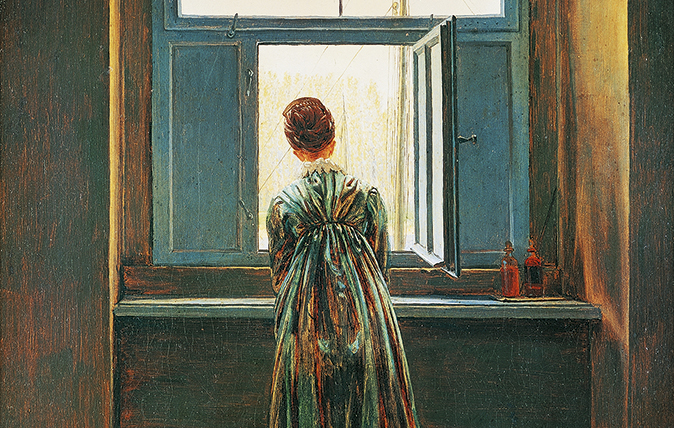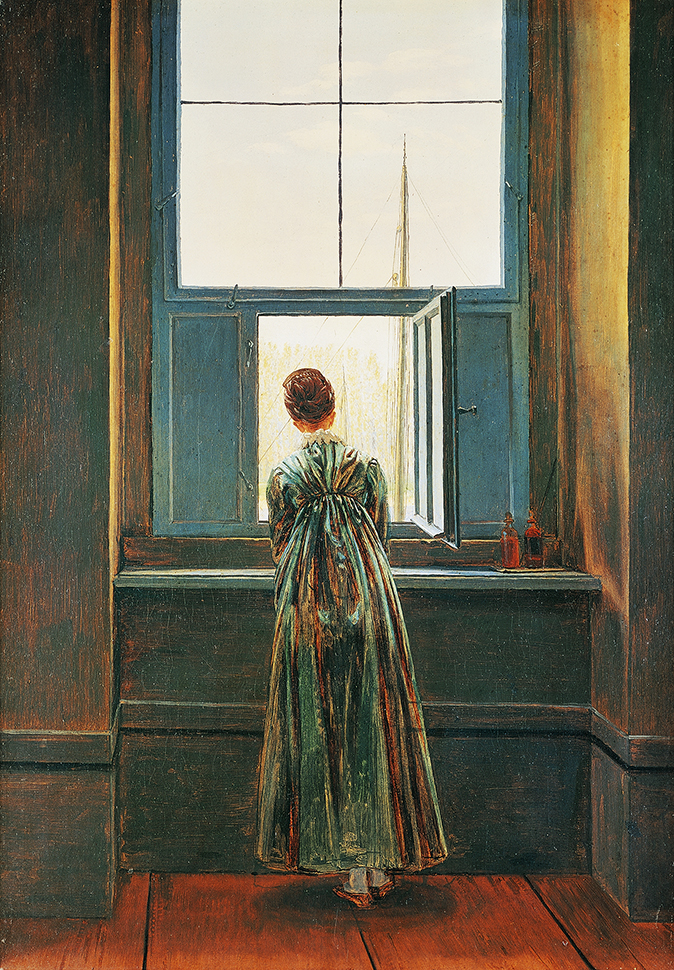My favourite painting: Bruce Boucher
'The image piqued my curiosity through its sense of mystery and expectation'



Woman at a Window (Frau am Fenster), 1822, by Caspar David Friedrich (1774–1840), 17½in by 15in, Nationalgalerie, Berlin
Bruce Boucher says: I first became aware of Caspar David Friedrich through an exhibition at the Tate in 1972, but I associate Woman at a Window with the cover of a Penguin Classic, Lotte in Weimar by Thomas Mann. I bought a lot of Penguin Classics in those days because of their covers, which were designed by the legendary Gerald Cinamon. In this case, the image piqued my curiosity through its sense of mystery and expectation. Friedrich’s painting has haunted me ever since and I often return to it, wanting to know what that woman is looking at and what she’s thinking ’
Bruce Boucher is the director of Sir John Soane’s Museum
John McEwen comments on Woman at a Window: In 1818, Friedrich married Caroline Bommer (1793–1847). A year later, to accommodate their first child, they moved to a house on the Elbe. This picture dates from around a time when Caroline was away visiting friends. Its mood mirrors a letter he sent her: ‘Everything is quiet, quiet, quiet here; this quiet is good for me, to be sure, but I would not wish to have so much quiet around me always. I eat my breakfast alone… I have my midday meal alone, my supper alone.’
Only when out walking in the midst of Nature did he feel less isolated: ‘He who made heaven and earth is around me, and His love sustains me, and may His love sustain you and all our friends.’ Friedrich was a convinced Christian, imbued by a strict Lutheran upbringing.
Although not stated, this is surely Caroline looking out across the Elbe to the poplars on its far bank, the masts of two ships asserting the presence of the only minimally suggested river. The stark room seems to be Friedrich’s studio. Perhaps he painted her imagined presence?
The window bars form a cross. In Protestant New England, this was called a ‘religious window’. Of an earlier picture he painted of a cross, Friedrich wrote: ‘To those who see it, a comfort, to those who do not see it, a cross.’ The same can apply here. Some will see window bars, others a cross and, more than that, a comfort, the love of ‘He who made heaven and earth’—in Friedrich’s case, sustaining his family, their friends and himself.
Sign up for the Country Life Newsletter
Exquisite houses, the beauty of Nature, and how to get the most from your life, straight to your inbox.
Country Life is unlike any other magazine: the only glossy weekly on the newsstand and the only magazine that has been guest-edited by HRH The King not once, but twice. It is a celebration of modern rural life and all its diverse joys and pleasures — that was first published in Queen Victoria's Diamond Jubilee year. Our eclectic mixture of witty and informative content — from the most up-to-date property news and commentary and a coveted glimpse inside some of the UK's best houses and gardens, to gardening, the arts and interior design, written by experts in their field — still cannot be found in print or online, anywhere else.
-
 Rodel House: The Georgian marvel in the heart of the Outer Hebrides
Rodel House: The Georgian marvel in the heart of the Outer HebridesAn improving landlord in the Outer Hebrides created a remote Georgian house that has just undergone a stylish, but unpretentious remodelling, as Mary Miers reports. Photographs by Paul Highnam for Country Life.
By Mary Miers
-
 380 acres and 90 bedrooms on the £25m private island being sold by one of Britain's top music producers
380 acres and 90 bedrooms on the £25m private island being sold by one of Britain's top music producersStormzy, Rihanna and the Rolling Stones are just a part of the story at Osea Island, a dot on the map in the seas off Essex.
By Lotte Brundle
-
 'As a child I wanted to snuggle up with the dogs and be part of it': Alexia Robinson chooses her favourite painting
'As a child I wanted to snuggle up with the dogs and be part of it': Alexia Robinson chooses her favourite paintingAlexia Robinson, founder of Love British Food, chooses an Edwin Landseer classic.
By Charlotte Mullins
-
 The Pre-Raphaelite painter who swapped 'willowy, nubile women' for stained glass — and created some of the best examples in Britain
The Pre-Raphaelite painter who swapped 'willowy, nubile women' for stained glass — and created some of the best examples in BritainThe painter Edward Burne-Jones turned from paint to glass for much of his career. James Hughes, director of the Victorian Society, chooses a glass masterpiece by Burne-Jones as his favourite 'painting'.
By Charlotte Mullins
-
 'I can’t look away. I’m captivated': The painter who takes years over each portrait, with the only guarantee being that it won't look like the subject
'I can’t look away. I’m captivated': The painter who takes years over each portrait, with the only guarantee being that it won't look like the subjectFor Country Life's My Favourite Painting slot, the writer Emily Howes chooses a work by a daring and challenging artist: Frank Auerbach.
By Toby Keel
-
 My Favourite Painting: Rob Houchen
My Favourite Painting: Rob HouchenThe actor Rob Houchen chooses a bold and challenging Egon Schiele work.
By Charlotte Mullins
-
 My Favourite Painting: Jeremy Clarkson
My Favourite Painting: Jeremy Clarkson'That's why this is my favourite painting. Because it invites you to imagine'
By Charlotte Mullins
-
 The chair of the National Gallery names his favourite from among the 2,300 masterpieces — and it will come as a bit of a shock
The chair of the National Gallery names his favourite from among the 2,300 masterpieces — and it will come as a bit of a shockAs the National Gallery turns 200, the chair of its board of trustees, John Booth, chooses his favourite painting.
By Toby Keel
-
 'A wonderful reminder of what the countryside could and should be': The 200-year-old watercolour of a world fast disappearing
'A wonderful reminder of what the countryside could and should be': The 200-year-old watercolour of a world fast disappearingChristopher Price of the Rare Breed Survival Trust on the bucolic beauty of The Magic Apple Tree by Samuel Palmer, which he nominates as his favourite painting.
By Charlotte Mullins
-
 My favourite painting: Andrew Graham-Dixon
My favourite painting: Andrew Graham-Dixon'Lesson Number One: it’s the pictures that baffle and tantalise you that stay in the mind forever .'
By Country Life